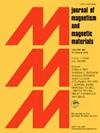Pinning of domain walls in epitaxial garnet film patterned by surface arrays of ferromagnetic metal particles
IF 2.5
3区 材料科学
Q3 MATERIALS SCIENCE, MULTIDISCIPLINARY
引用次数: 0
Abstract
Rare-earth iron garnet epitaxial films famous for their unique magnetic, microwave and optical properties consistently attract high interest. Domain structure of both bulk and interfaces of garnet films is closely connected with their magnetic properties and magnetization dynamics. In this work, we investigate the magnetic behaviour and domain structure of an epitaxial bismuth-substituted lutetium iron garnet film with a regular array of planar submicron particles made of Co film or Co/Pt multilayer on its surface. Optical polarization microscopy and magnetic force microscopy techniques used for the characterization of these composite structures confirm the mutual influence of the garnet and metal nanostructured layers on each other. On the one hand, dense ordered metal particles provide the pinning of the surface magnetic domains of the garnet film, which further affects the organization of the bulk stripe domains. On the other hand, we observed that the domain structure in the metallic pattern is governed by the domain structure of the garnet placed beneath it.
铁磁性金属颗粒表面阵列图案化的外延石榴石薄膜中的畴壁钉扎现象
稀土铁石榴石外延薄膜以其独特的磁性、微波和光学特性而闻名,一直以来都备受关注。石榴石薄膜块体和界面的畴结构与其磁性能和磁化动态密切相关。在这项工作中,我们研究了铋取代镥铁石榴石外延薄膜的磁行为和畴结构,该薄膜表面有由 Co 薄膜或 Co/Pt 多层制成的规则平面亚微米粒子阵列。用于表征这些复合结构的光学偏振显微镜和磁力显微镜技术证实了石榴石层和金属纳米结构层之间的相互影响。一方面,致密有序的金属颗粒为石榴石薄膜的表面磁畴提供了引脚,从而进一步影响了块状条纹磁畴的组织。另一方面,我们观察到金属图案中的磁畴结构受置于其下的石榴石磁畴结构的支配。
本文章由计算机程序翻译,如有差异,请以英文原文为准。
求助全文
约1分钟内获得全文
求助全文
来源期刊

Journal of Magnetism and Magnetic Materials
物理-材料科学:综合
CiteScore
5.30
自引率
11.10%
发文量
1149
审稿时长
59 days
期刊介绍:
The Journal of Magnetism and Magnetic Materials provides an important forum for the disclosure and discussion of original contributions covering the whole spectrum of topics, from basic magnetism to the technology and applications of magnetic materials. The journal encourages greater interaction between the basic and applied sub-disciplines of magnetism with comprehensive review articles, in addition to full-length contributions. In addition, other categories of contributions are welcome, including Critical Focused issues, Current Perspectives and Outreach to the General Public.
Main Categories:
Full-length articles:
Technically original research documents that report results of value to the communities that comprise the journal audience. The link between chemical, structural and microstructural properties on the one hand and magnetic properties on the other hand are encouraged.
In addition to general topics covering all areas of magnetism and magnetic materials, the full-length articles also include three sub-sections, focusing on Nanomagnetism, Spintronics and Applications.
The sub-section on Nanomagnetism contains articles on magnetic nanoparticles, nanowires, thin films, 2D materials and other nanoscale magnetic materials and their applications.
The sub-section on Spintronics contains articles on magnetoresistance, magnetoimpedance, magneto-optical phenomena, Micro-Electro-Mechanical Systems (MEMS), and other topics related to spin current control and magneto-transport phenomena. The sub-section on Applications display papers that focus on applications of magnetic materials. The applications need to show a connection to magnetism.
Review articles:
Review articles organize, clarify, and summarize existing major works in the areas covered by the Journal and provide comprehensive citations to the full spectrum of relevant literature.
 求助内容:
求助内容: 应助结果提醒方式:
应助结果提醒方式:


